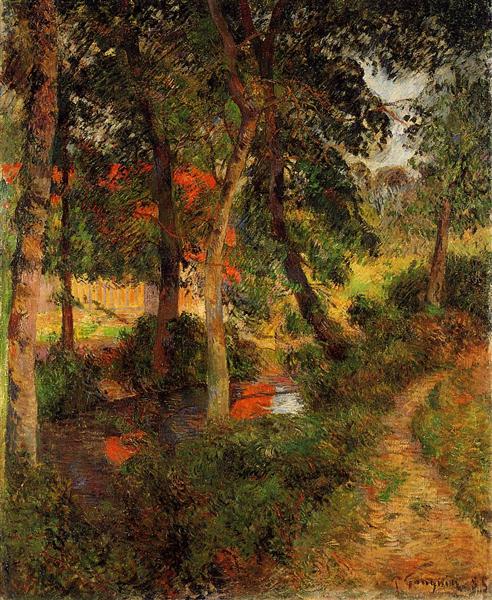Beschreibung
In der Arbeit "Der Weg von Pere Jean" (1885) von Paul Gauguin, den Prinzipien der Symbolik und des Post -Impressionismus, definierten Merkmale, die den Stil des Künstlers und seine Suche nach einem tieferen Ausdruck durch Farbe und Form definierten. Dieses Gemälde, weniger bekannt als andere Gauguin -Meisterwerke, bietet vor seiner berühmten Reise nach Tahiti und seiner künstlerischen Entwicklung während seines Aufenthalts in Frankreich ein Fenster zu seinem Leben.
Die Zusammensetzung der Arbeit ist überwiegend horizontal, was auf einen Pfad hindeutet, der sich in der Ferne erstreckt, und den Betrachter einlädt, der visuellen Route zu folgen. Die Straße, die zu einem Hintergrund voller Vegetation führt, ruft ein Gefühl der Suche und Erkundung hervor. Diese Darstellung der Landschaft ist nicht darauf beschränkt, eine einfache natürliche Sichtweise zu sein. Darin gelingt es Gauguin, einem Raum voller Symbolik und emotionalen Nuancen Leben zu geben. Auf dem Weg werden Bäume, die an den Seiten auftreten, beobachtet, was ein Gefühl der Nähe zur Natur, aber auch der Isolation verleiht, als wäre die zentrale Figur der einzige Protagonist in einer riesigen und mysteriösen Welt.
Im Zentrum der Arbeit taucht eine männliche Figur auf, die in ihrem Leitfaden oder vielleicht dem Kontemplator mit Bedacht zu bedenken scheint. Seine Haltung und Kleidung deuten auf eine kulturelle Verbindung hin, auch wenn sie nicht explizit definiert ist. Die Figur ist von einer farbigen Palette umgeben, die von intensivem Grün zu Ocker- und gelben Tönen übergeht und das Sonnenlicht und den Reichtum der Flora hervorruft. Diese lebendigen Farben, die mit einer Technik von losen Pinselstrichen angewendet werden, sind repräsentativ für Gauguins Wunsch, sich der naturalistischen Darstellung gegenüber einer emotionaleren und symbolischeren Verwendung von Farbe zu entfernen.
Der Kontrast zwischen warmen und kalten Farben sowie die Nutzung des Raums schafft eine fast mystische Atmosphäre. Das Licht, das durch Laub gefiltert wird, erzeugt Schatten, die ein Gefühl von Tiefe und Volumen vermitteln, was auf einen Einfluss der impressionistischen Malerei hinweist, während gleichzeitig Gauguins mutige Erkundungen in seiner nachfolgenden Arbeiten vorweggenommen werden. Die allgemeine Atmosphäre des Gemäldes deutet auf einen Zustand der Selbstbeobachtung und Frieden hin, der eine spirituelle Suche widerspiegelt, die Gauguin in seiner hinteren Karriere mit größerer Dynamik umarmen würde.
Gauguin, bekannt für seinen Wunsch, das Exotische und emotionale in einem westlichen Kontext darzustellen, begann bereits Ideen zu gestikulieren, die ihn dazu bringen würden, Themen des "Primitivismus" in seinen nachfolgenden Werken zu erforschen. "Pere Jean's Path" kann dann als Vorläufer für seine Betonung der Elemente des einfachen und spirituellen Lebens interpretiert werden, das später in seinen Werken von Tahiti emblematisch anbieten würde.
Die Kombination dieser lebendigen Palette mit einer Komposition, die sich um eine introspektive Figur dreht, fügt den Beobachter nicht nur an einem physischen Ort, sondern auch in einem emotionalen Zustand ein. Das Gemälde, obwohl es in Gauguin möglicherweise nicht das am bekannteste ist, verkaps das Ethos seiner künstlerischen Erforschung: den Wunsch nach Sinn, Verbindung mit der Natur und Relevanz persönlicher Erfahrung in der künstlerischen Schöpfung. In "The Path of Pere Jean" bietet Gauguin uns einen Einblick in seine innere Welt und seine unaufhörliche Suche nach Schönheit in der Einfachheit und Tiefe der emotionalen Landschaft, die uns umgibt.
KUADROS ©, eine berühmte Farbe an Ihrer Wand.
Handgemachte Ölgemälde, mit der Qualität professioneller Künstler und dem unverwechselbaren Siegel von KUADROS ©.
Pictures Reproduction Service mit Zufriedenheitsgarantie. Wenn Sie mit der Nachbildung Ihres Gemäldes nicht vollständig zufrieden sind, erstatten wir Ihr Geld zu 100%.

